In the early 1990s more than a thousand karretjiemense eked out a living as nomadic sheep shearers trekking across the Great Karoo. That way of life is now lost because their artisanal skills, in the face of mechanisation, are not needed. But the karretjie people, who have always lived on the margins, remain and survive on the veld, odd jobs and social grants.
It’s daybreak on the dusty plains south of Colesberg in the Northern Cape. Outside her rusted shack at Garings Outspan, Liesbet Booysen (31) blows on the embers of last night’s fire to spark a flame.
In the distance she sees two crows plummeting towards the ground and she knows what that means. Booysen wakes Breyten, her six-year-old son. With sleep in his eyes he sets off on a grown-up bicycle, pumping legs that are just long enough for his bare feet to reach the pedals.
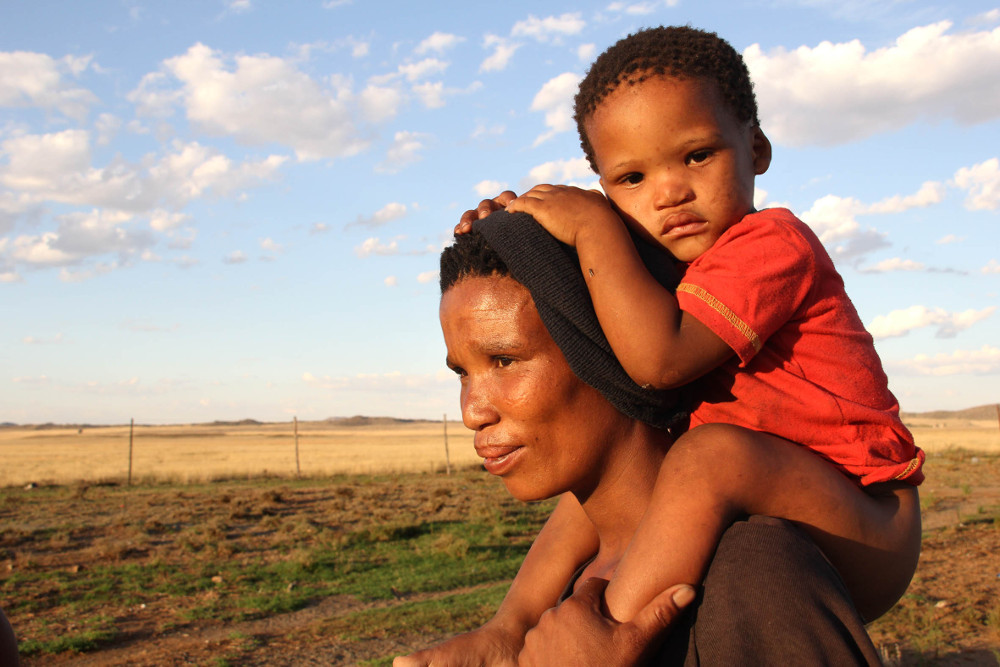
Liesbet Booysen and her three-year-old Brendan live at Garings Outspan with the few remaining karretjiemense. They continue to live next to the dirt road outside Colesberg, relying on old connections with farmers for odd jobs. (Daneel Knoetze)
Sometimes you’ve got bad luck and the roadkill may be too small or too badly damaged to be of use. But today Breyten is successful: he returns with the carcass of a small steenbok on the handlebars.
Booysen holds the carcass up to the light and picks bits of dirt from the crushed skull. The wound is fresh, and blood oozes. She will clean, skin and gut the buck and hang tiny red strips of meat to dry from the ceiling of her shack. In this setting of abject poverty, the veld still provides.
Half a dozen families live at Garings Outspan. Each brown shack is furnished with little more than a mattress on the ground. These families are among the last karretjiemense (cart people) who still live next to the dirt roads outside Colesberg. Only three donkey carts have survived from the old days. One of these lies useless, its wheels stolen months ago.
Rural existence
Booysen, her partner Hendrik Hermanus and their respective brothers and sisters grew up on the road. Descendants of the Bushmen, the karretjie people moved from farm to farm across the Great Karoo. As one of about 1 000 karretjie units operating in the early 1990s, Booysen’s family earned small commissions for shearing sheep and hand-processing the wool.
Visits to the town are brief and usually only to buy basic supplies. For the rest her family scrounges what it can – firewood from the veld, water from farm reservoirs and meat from hunted animals like the rooikat (caracal).
Nights are spent beside a fire and in low shacks on the kortgangetjie (narrow corridor) between the dirt roads and the fences of the big merino sheep farms.
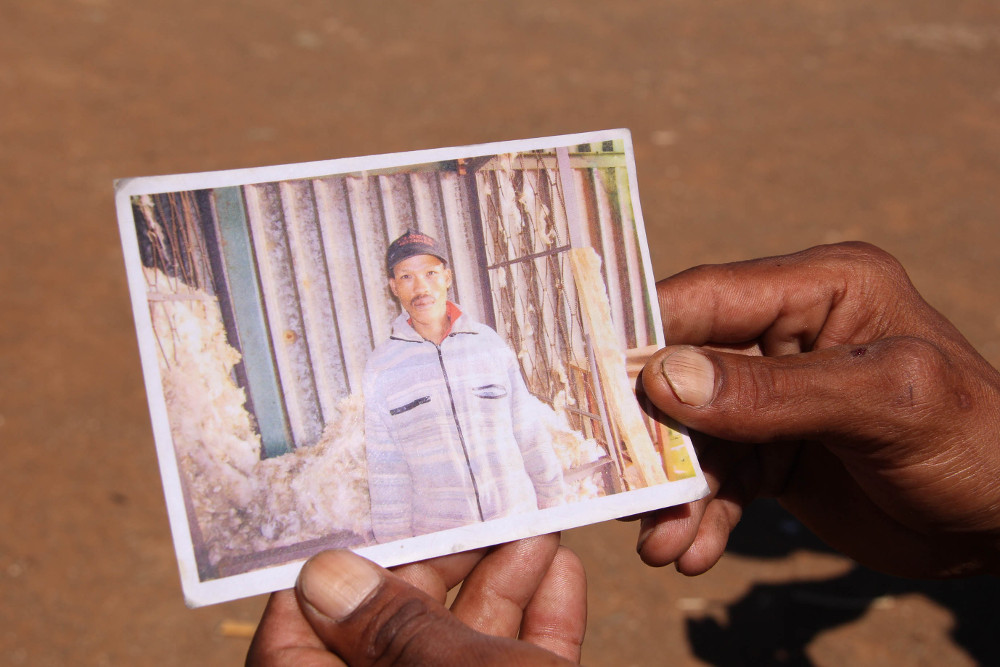
Karretjie stalwart Piet Louw recalls that his last real job as a shearer was in 2009, before he became redundant. (Daneel Knoetze)
Farmer Danie van Zyl, the owner of the land on which Garings Outspan lies, remembers the karretjie people from his youth. He recalls their Afrikaans vernacular, which was strange to him – the lucidity and poetry of the shearers’ chat as they worked in his father’s shed for a few days each year. He remembers the neatness of their work and the speed and skill with which the small men handled a full-grown ram. He compares this with the clumsiness of today’s shearers, men with electric shears and no feel for their work.
With mechanised shearing and the consolidation of small farms into fewer and larger enterprises, the need for the karretjie people’s artisanal skills, once an indispensable part of the rural economy, has fallen away, Van Zyl explains. But the old families have remained – coerced into an impossible choice between a wretched existence on the fringes of the farms and moving to town to try to sell their labour in the midst of chronic unemployment.
Town folk
Hanneline and Izak Louw have chosen the town. Izak is the second-youngest son of Oupa Lodewyk Slinger, a legendary karretjie patriarch who fathered 12 sons and is soon to celebrate his 101st birthday in Colesberg.
In the late 1990s Izak migrated to the wine farms of the Western Cape in search of formal work. He married Hanneline from Franschhoek, quit alcohol and became a devout Rastafarian – “die Boesman was mos die oorspronklike Rasta [the Bushman was the original Rasta]”, he says. After years away, Izak returned from the Cape with his wife to care for his ailing parents at the Lowrysville squatter camp outside Colesberg (an erstwhile outspan for karretjie people on town visits). He says he was “burning” for the land where his “umbilical cord lies buried”.
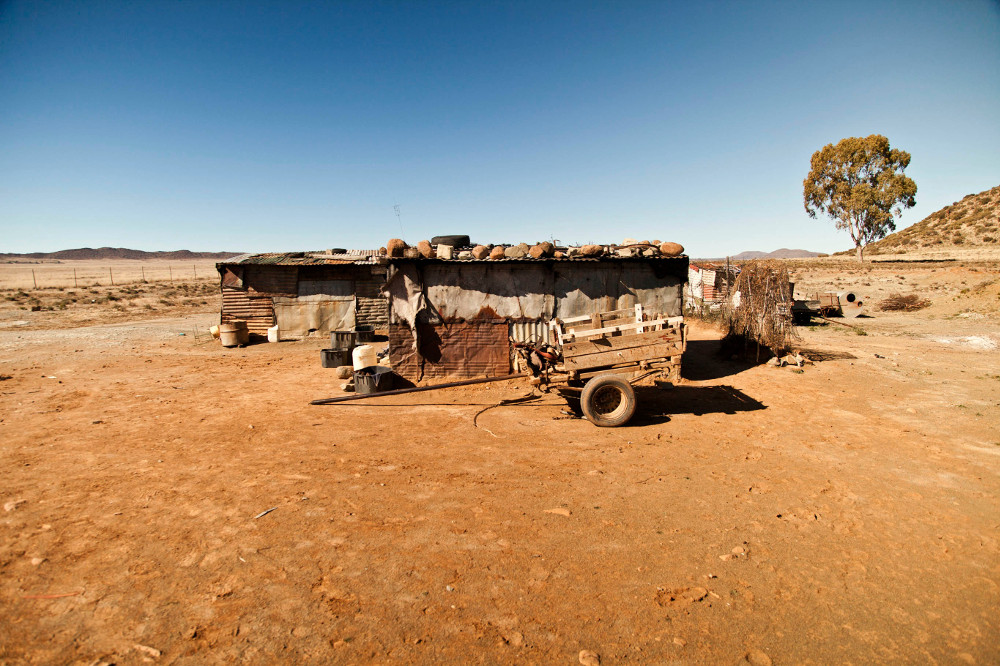
Garings Outspan near Colesberg in the Karoo. (Timothy Gabb)
Hanneline, energetic and educated, successfully applied for a house with running water and electricity in the large Riemvasmaak government housing development outside Colesberg.
She is proud that the application was granted in time for the family to celebrate Oupa’s 100th birthday in a brick house last year. Though his eyes, his smile and his gestures of greeting or farewell are alert, the old man can no longer speak. His wife, Sina Louw – 20 years his junior – says they had hardly ever spent a night inside a house in the 60 years of their marriage.
Another of their sons, Salman Louw (55), also moved back to Colesberg after a period in the employ of the late Afrikaner Weerstandsbeweging leader, Eugene Terre’Blanche.
Salman speaks of Terre’Blanche as a father. He is proud that Terre’Blanche trusted him enough to train him as a soldaat (soldier) and to give him basic instruction in firearm usage. This he demonstrates by squatting low and taking aim with an imaginary rifle.
‘Long life’
About his real father, Oupa Lodewyk Slinger, Salman says: “Oupa [Lodewyk] was a gentle man.” Explaining his father’s longevity: “He would not drink so hard or be prone to stabbing and fighting with the other men when he was younger. He was a very proud man, and good with donkeys like no man I have ever seen. Now, he has been blessed with a long life.”
Outside the Riemvasmaak house, the grandchildren help move Oupa’s chair around the house, following the progression of the shade from the morning to evening. He sits still, smoking newspaper cigarettes and the occasional marijuana joint, rolled for him by his sons.
The house has running water, electricity and a toilet – unknown amenities on the shearing trail through the Karoo. Izak has no nostalgia for the old life – it was too hard. Of his childhood on the road, he recalls that there were no new clothes or feasts at Christmas and that he and his brothers would nestle “like small, wet chickens” under a tarpaulin too small to cover them when it was cold and raining.
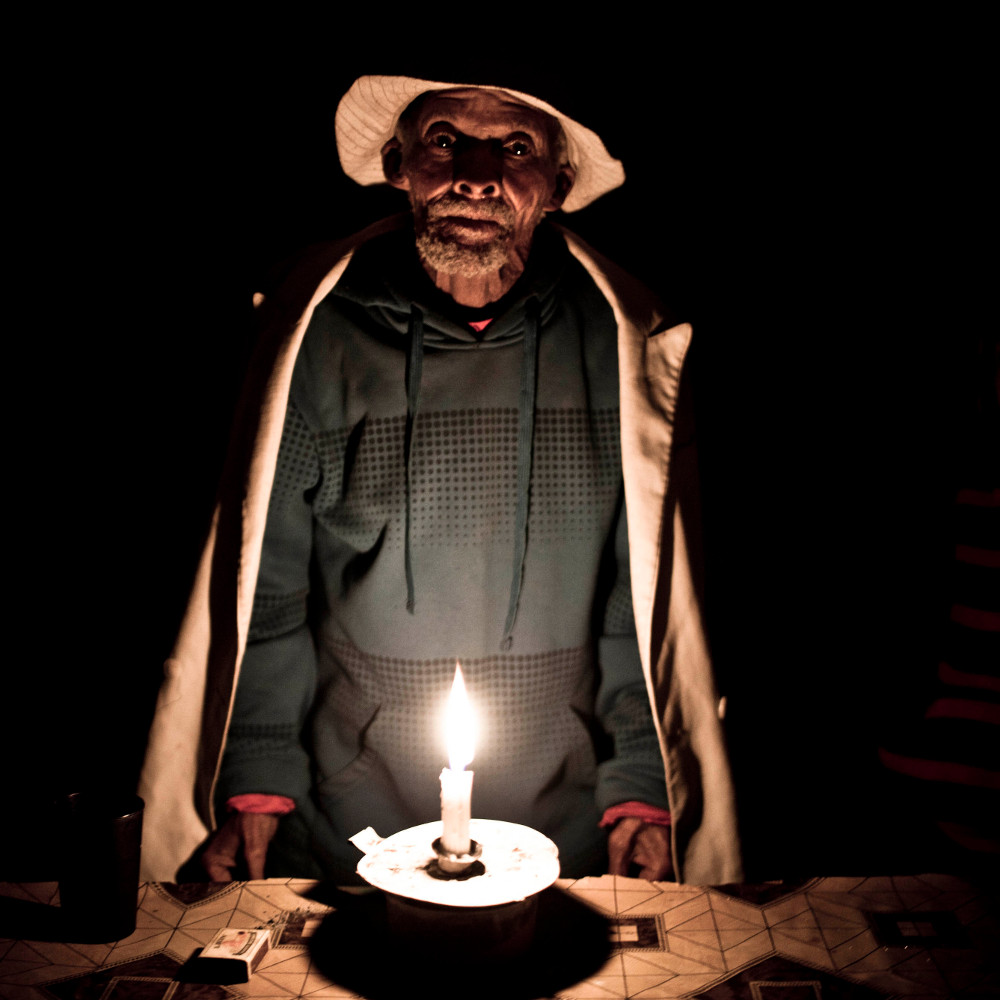
Karretjie patriarch Lodewyk Slinger celebrated his 100th birthday in a brick house. (Russell Bruns)
But in Colesberg there are few jobs, and the family ekes out an existence through government grants for the children and the pensions of Oupa Lodewyk and Ouma Sina.
Piet Louw, their youngest son, nostalgically shows a photo of himself at the last sheep-shearing job he did in the region in 2009.
“That life was not so bad, as they say. At least we had work. Here there is nothing for us now.”
Old connections
The difficulty of finding work in town keeps Liesbet Booysen and her family from migrating to Colesberg. Sitting on a paint drum in the dust, she lists six farms surrounding Garings Outspan where the family can count on old connections for periodic “los werk [odd jobs]”. Colesberg, with its bottomless labour supply, is 50km away so men like her partner stand a better chance of sporadic employment staying where they are. But even so, weeks may pass with no work and no pay, she says.
Thanks to the Hantam Community Education Trust, which provides support and schooling for poor rural children, the couple’s kids have the chance of an education previously not available to families living on the Karoo’s social margins. Breyten and his younger sister are in grades one and R respectively. Their parents are proud to display the children’s drawings and colouring-in books – proof that they are being formally educated.
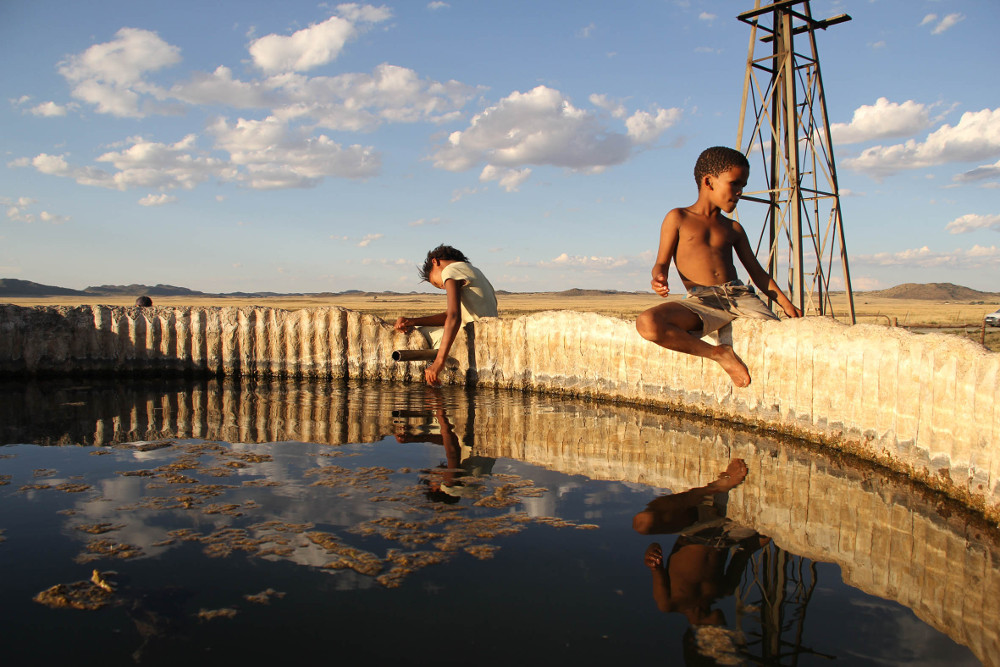
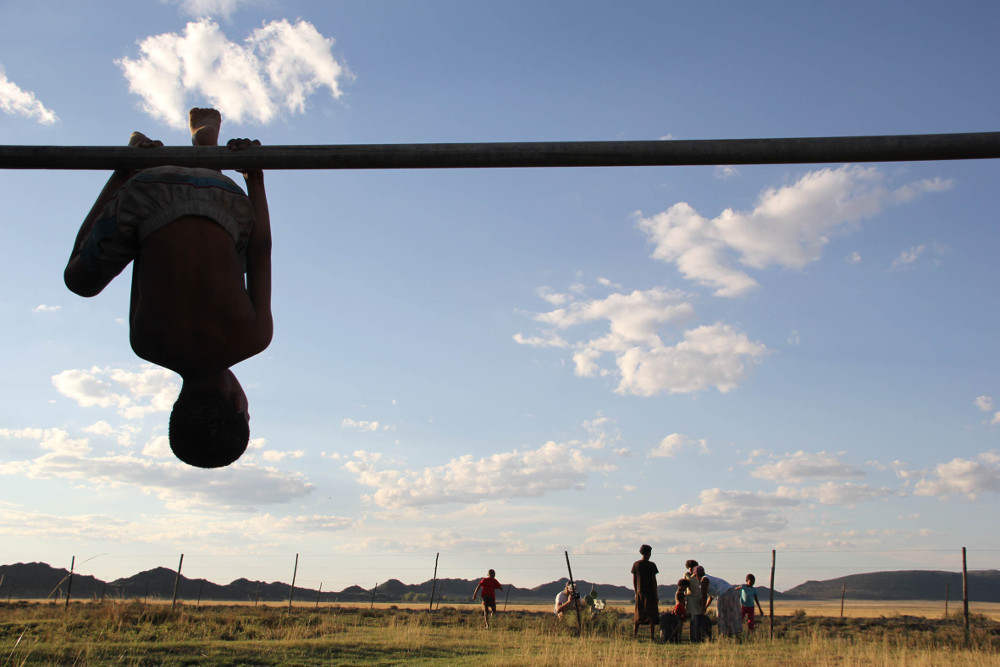
Karretjie children Sussie Joggem and Breyten Booysen play at the reservoir. (Daneel Knoetze)
But the potential for learning through the education trust is limited by chronic alcohol abuse. Hannah Mthembu, a teacher at the trust, is concerned about the home environment and development of children in poor, off-the-grid communities like Garings.
Dealing with learning disabilities associated with foetal alcohol syndrome in her pupils is a daily challenge of her work.
“Pregnant women still have this belief that alcohol doesn’t make a difference to the development of their child,” says Mthembu. “People now know what Aids is, yes, because there was a huge campaign to educate these rural people. But people have not been taught about [foetal alcohol syndrome] in the same way. It does unbelievable damage to these kids; they struggle. It’s so, so sad because the child has been hurt without deserving it.
“So, what we are trying to do is to empower these kids now, so that one day they can make a better choice for when they have children.”
Booysen also wants the best for her children, and she believes the old life of veld and road is best.
“We have a place in town. But that is not the life we have come to know. I like the veld and the donkeys. I know nothing of electric lights and taps and warm water. It is a fire and a wind pump that I know. I did not need those fancy things when I was young and I still feel young. Maybe one day when we are old people and cannot work it will be different, but not yet.”
The sources interviewed for this article are protagonists in Move: The Lost Carts of the Karoo, a forthcoming documentary film by Timothy Gabb. The film, which is supported by playwright Athol Fugard, is being produced independently and relies on crowdfunding. To find out more or to support the project, visit facebook.com/karretjiemense or gabfly.co.za.
This article was originally published by GroundUp.